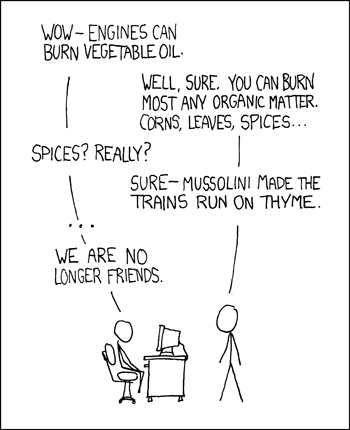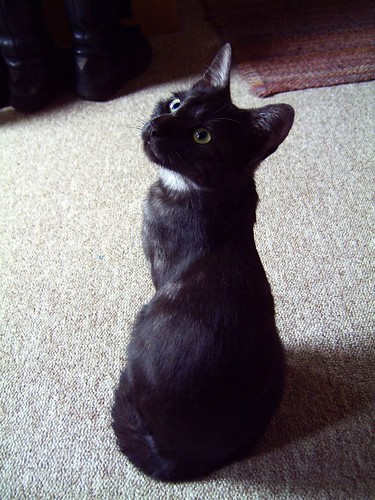
FELINE LAWS OF PHYSICS
Cats have their own rules of physics. Here are some of them.
Newton’s First Law of Cat Inertia
A cat at rest will tend to remain at rest, unless acted upon by some outside force - such as the opening of a can or the sight of a prey.
Newton’s First Law of Cat Motion
A cat will move in a straight line, unless there is a really good reason to change direction.
Newton’s Law of Feline Acceleration
A cat continues to accelerate at a constant speed until he needs to stop.
Newton’s First Law of Pill Rejection
Any pill given to a cat has the potential energy to reach escape velocity.
Newton’s Second Law of Pill Rejection
Any cat restrained for the purposes of administering a pill has the potential to reach escape velocity.
Newton’s Law of Concentration of Mass
A cat’s mass increases in direct proportion to the comfort of the lap she occupies.
Newton’s Law of Feline Gravity Manipulation
Cats have the ability manipulate gravity, forming localised areas of strong gravitational attraction. This gives the impression of a cat growing heavier as it occupies a lap or bed. This is a linear effect with gravity increasing at a steady rate over time.
First Law of Energy Conservation (Feline Thermodynamics Law 1)
Cats know that energy can neither be created nor destroyed and will therefore use as little energy as possible.
Second Law of Energy Conservation (Feline Thermodynamics Law 2)
Cats know that energy can only be stored by a lot of napping.
Third Law of Energy Conservation (Feline Thermodynamics Law 3)
If the rate of energy uptake exceeds the maximum rate of energy storage, the difference will be emitted in the form of purring.
Boyle’s Law of Cat Thermodynamics
Heat flows from a warmer to a cooler body, except in the case of a cat, in which case all heat flows to the cat.
Kirk’s Law of Cat Magnetism
Dark coloured clothing attracts light coloured cat hair in direct proportion to the darkness of the fabric. The converse is also true.
Fanner’s First Law of Cat Stretching (Nap-Associated Stretching)
A cat will stretch to a distance proportional to the length of the nap just taken.
Fanner’s Second Law of Cat Stretching (Non-Nap-Associated Stretching)
The length of the stretch is directly proportional to temperature. Nose in tail (unstretched) is ‘cold’ while fully stretched is ‘hot’. There are infinite gradations on this stretch/temperature scale.
Young’s Law of Cat Sleeping
All cats must sleep with people whenever possible.
Kent’s Corollary Young’s Law of Cat Sleeping
The cat must select a position which causes maximum discomfort to people involved.
Holmes’ Law of Vertical Feline Elongation
A cat can make its body long enough to reach the top of any surface which has anything remotely interesting on it.
Burt’s Corollary to Holmes’ Law of Vertical Feline Elongation
The cat can exceed its normal elongation if the item of interest is edible.
Burt’s Law of Dinner Table Attendance
Cats will attend all family meals when anything good is served.
Burt’s Law of Selective Listening
A cat can hear a can of tuna being opened (or the word ‘vet’) a mile away, but can’t hear a simple command three feet away.
Euler’s Law of Rug Configuration
When a cat is present, no rug may remain in its naturally flat state for long.
Ohm’s Law of Obedience Resistance
A cat’s resistance varies in inverse proportion to a humans desire for her to do something.
Henry’s Law of Refrigerator Observation
If a cat watches a refrigerator long enough, someone will come along and take out something good to eat.
Revised Henry’s Law of Kitchen Appliance Observation
If a cat watches a refrigerator, a stove, a kitchen cupboard or a microwave oven long enough, someone will come along and take out something good to eat.
Partington’s Addition to Revised Henry’s Laws of Kitchen Appliance Observation
If a cat stands directly behind a human in the kitchen, its tail will be trodden on; the human will then offer the cat something good to eat by way of apology.
Einstein’s Law of Electric Blanket Attraction
Turn on an electric blanket and a cat will jump into bed at the speed of light.
Einstein’s Law of Space-Time Continuum as Applicable to Felines
Given enough time, a cat will land in just about any space.
Einstein’s Law of Cat Composition
A cat is composed of Matter + Anti-Matter + It Doesn’t Matter.
Cheung’s Law of Random Comfort Seeking
A cat will always seek, and usually take over, the most comfortable spot in any given room.
Colling’s Law of Cat Disinterest
A cat’s interest level will vary in inverse proportion to the amount of effort a human expends in trying to interest him.
Collings’ Law of Cat Embarrassment
A cat’s irritation rises in direct proportion to its embarrassment multiplied by the amount of human laughter. (Amount of human laughter = volume x duration2)
Collings’ Law of Feline Vomiting
The frequency that a cat vomits on a given surface is directly proportional to the difficulty of cleaning the given surface and also proportional the likelihood of the given surface to acquire permanent stains.
Cheung’s Modification to Collings’ Law of Feline Vomiting
The frequency that a cat vomits, pees or has diarrhoea on a given surface is directly proportional to the difficulty of cleaning the given surface and also proportional the likelihood of the given surface to acquire permanent stains and odours.
Cheung’s Law of Furniture Replacement
A cats desire to scratch furniture is directly proportional to the cost of the furniture.
Cheung’s Law of Cat Landing
A cat will always land in the softest place possible.
Cheung’s Second Law of Cat Landing
A cat will always land on its feet unless you are unpacking groceries, in which case it will land on your feet.
Schrodinger’s Law of Cat Invisibility
Cats think that if they can’t see you, then you can’t see them.
Schrodinger’s Accidentally Discovered Law of Object Occupancy
All bags and boxes in a given room must contain a cat within the earliest possible nanosecond.
Heisenberg’s Law of Cat Probability (Heisenberg’s Uncertainty Principle as Applied to Cats)
It is not possible to predict where a cat actually is, only the probability of where it “might” be. As soon as you know where it is, it will move.
Pythagoras’ Theorem of Feline Equidistant Separation
All cats in a given room will be located at points equidistant from each other, and equidistant from the centre of the room. The time taken to achieve equidistant spacing is proportional to the number of cats present.
Pratchett’s Rule of Cat Chess
Where multiple cats are present in a large finite space, each cat must attempt to see at least two other cats but remain hidden from view itself.
Protagoras’ Rule of Cat Obedience
As a rule, cats aren’t obedient.
Aristotle’s Law of Fluid Displacement
A cat immersed in milk will displace her own volume, minus the amount of milk consumed.
Law of Milk Consumption (Feline Capacitance)
A cat will drink his weight in milk, squared, just to show you he can. After a suitable delay







